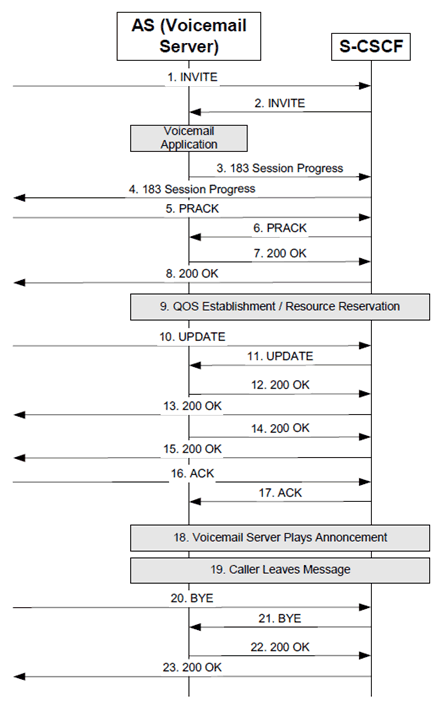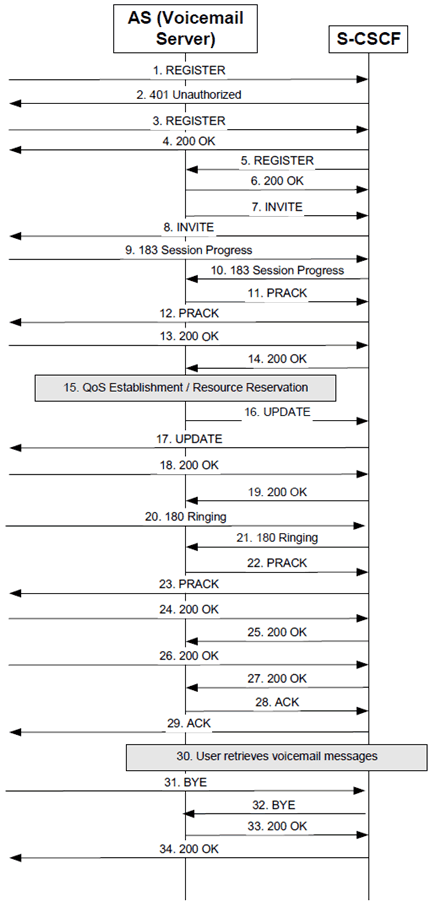Content for TS 23.218 Word version: 18.0.0
B.3 Example information flows for a voicemail service
B.3.1 User out of coverage message recording
B.3.2 User IMS registers voice mail service plays back messages
B.3 Example information flows for a voicemail service p. 64
B.3.1 User out of coverage message recording p. 64
Figure B.3.1.1 shows a possible scenario of an Application Server, which acting as a terminating UA performs the function of a Voicemail Server in order to terminate a call and record a message on behalf of a UE that is out of coverage or powered off. The Application Server's use of the MRF to record a message is not shown in this example.
An initial INVITE destined for a UE that is not currently IMS registered is forwarded to a S-CSCF. The Default Filter Criteria in the S-CSCF indicates that for the case of an unregistered user the INVITE request should be forwarded to the Voicemail and Announcement Server.
Upon receiving the INVITE request the Voicemail and Announcement Server determines that the destination UE has subscribed to the Voicemail Service (possibly by downloading some subscriber profile information via the Sh interface). The Voicemail and Announcement Server therefore in addition to playing an announcement to inform the caller that the called party is either powered off or out of coverage also informs the caller that he may leave a message for the called party.
The calling party leaves a message for the called party and then hangs up the call by sending a BYE request.

Notes for Figure B.3.1.1:
Step 1.
INVITE request destined for an unregistered user is received at the S-CSCF.
Step 2.
Based on trigger point of the initial Filter Criteria S-CSCF proxies the INVITE request to the AS (Voicemail Server).
Step 3 - 4.
The AS starts the voicemail application and responds with a 183 (Session Progress) response containing SDP which is proxied back to the caller by the S-CSCF.
Step 5 - 8.
The caller responds with a PRACK request containing SDP, which the S-CSCF proxies to the AS and the AS responds with a 200 (OK) response containing SDP which the S-CSCF proxies back to the caller.
Step 9.
QOS establishment and resource reservation takes place.
Step 10 - 13.
After completing resource reservation the caller sends a UPDATE request containing SDP which is proxied by the S-CSCF to the AS which responds with a 200 (OK) response containing SDP which is proxied back to the caller by the S-CSCF.
Step 14 - 15.
The AS then sends a 200 (OK) response to the initial INVITE request which the S-CSCF proxies to the caller.
Step 16 - 17.
The caller returns an ACK request to the 200 (OK) response.
Step 18.
The AS plays an announcement using the session established indicating that the caller is powered off but that the caller may leave a message.
Step 19.
The caller leaves a message using the session established.
Step 20 - 21.
The caller hangs up by sending a BYE request which the S-CSCF proxies to the AS.
Step 22 - 23.
The AS responds with a 200 (OK) response, which the S-CSCF proxies back to the caller.
B.3.2 User IMS registers voice mail service plays back messages p. 66
Figure B.3.2.1 shows the scenario when the UE that has subscribed to a voicemail service with a feature enabled that contacts the user upon registration informing him of any recorded messages. The Application Server's use of the MRF to play announcements and to select and play the recorded messages is not shown in this example.
The Filter Criteria downloaded by the S-CSCF indicates that a third party REGISTER request should be sent to the Voicemail Server. Upon receiving the third party registration of the UE, the Voicemail Server acting as an originating UA contacts the UE by sending an INVITE request to inform him that he has voicemail messages recorded while he was not registered.
The user listens to the messages played back by the voicemail server, (only streaming class QOS is required for this session) and then terminates the session with a BYE request.

Notes for Figure B.3.2.1:
Step 1 - 4.
The UE sends a REGISTER request to the S-CSCF which authenticates with a 401 (Unauthorized) response challenge with the authentication response being supplied in a second REGISTER request. The registration completes with a 200 (OK) response from the S-CSCF to the UE.
Step 5 - 6.
The S-CSCF downloads Filter Criteria for the UE from the HSS which indicates the S-CSCF should send a third party REGISTER request on behalf of the UE to an AS that performs a voicemail service. The AS responds to the REGISTER request with a 200 (OK) response.
Step 7 - 8.
The AS downloads subscriber data for the subscriber (possibly from the HSS via the Sh interface) that indicates that the subscriber has enabled a feature that has the voicemail application contact the subscriber upon registration to deliver recorded messages. The AS sends an INVITE request containing SDP for the UE to the S-CSCF which proxies it to the UE.
Step 9 - 10.
The UE responds with 183 (Session Progress) response containing SDP which the S-CSCF proxies to the AS.
Step 11 - 14.
The AS sends a PRACK request, which the S-CSCF proxies to the UE and the UE respond with a 200 (OK) response which the S-CSCF proxies to the AS.
Step 15.
QOS establishment and resource reservation takes place.
Step 16 - 19.
The AS sends an UPDATE request, which the S-CSCF proxies to the UE and the UE responds with a 200 (OK) response which the S-CSCF proxies to the AS.
Step 20 - 21.
The UE sends a 180 (Ringing) response indicating that it is alerting the user which the S-CSCF proxies to the AS.
Step 22 - 25.
The AS to indicate receipt of the 180 (Ringing) response sends a PRACK request which the S-CSCF proxies to the UE and the UE responds with a 200 (OK) response which the S-CSCF proxies to the AS.
Step 26 - 27.
When the subscriber answers the UE sends a 200 (OK) response to the initial INVITE request which the S-CSCF proxies to the AS.
Step 28 - 29.
The AS acknowledges the 200 (OK) response with an ACK request which the S-CSCF proxies to the UE.
Step 30.
The AS plays an announcement indicating the number of messages stored and then plays back the messages to the UE using the session established.
Step 31 - 32.
The UE hangs up by sending a BYE request, which the S-CSCF proxies to the AS.
Step 33 - 34.
The AS responds with a 200 (OK) response, which the S-CSCF proxies back to the UE.